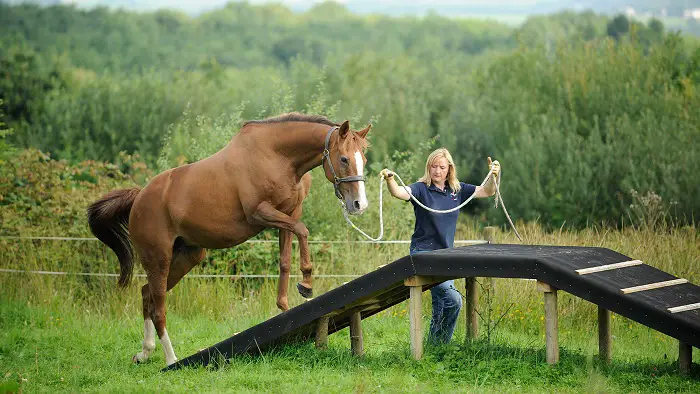Horse agility, also known as Equine agility, is a sport or training method similar to dog agility tests. In this training, horses are guided by a handler or rider to navigate obstacles. Initially, horses are tied with a guide rope and asked to negotiate the obstacle. They can navigate without any guide rope or halter as they progress, demonstrating their trust and understanding of the handler’s cues.
Equine agility competitions are conducted in a close arena. In them, the horses navigate and cross different obstacles without a handler in a specified time. You can train your horse for agility by following my guidelines and instructions.
Benefits of Horse Agility Training
Agility training in equines encompasses many physical and mental well-being for horses. The key benefits are as follows:
- Physical Development: Equine agility training enhanced the development of core muscles, muscle tone, and coordination.
- Mental Stamina: Agility training involves the horse using its brain to solve problems, thus enhancing mental stamina.
- Building Trust and Communication: Agility training creates an intense bondage between the horse and the handler.
What are the items included in Equine Agility Training?
The items commonly used in Equine agility training are versatile and diverse, offering a range of challenges for horses to overcome.
1. Pools and Rails. Pools can be placed on the ground or raised at considerable distances. Horses can cross over the pools to improve their awareness and foot placement.
2. Coones and Markers. These are placed on the ground in a serpentine or figure 8 pattern, and horses can move to improve their balance and coordination.
3. Tunnels. Lightweight tunnels made of plastic or enclosed tarpaulins allow the horse to move through a dark path. This exercise improves the horse’s courage while crossing through a heavy forest and strengthens the bond with the rider.
4. Bridges and Platforms. These are elevated platform obstacles made of wood or bamboo. Horses are trained to negotiate these obstacles to improve stamina, balance, and coordination on uneven surfaces.
5. Hoops and Rings. Horse agility training is given with hoops and rings at different heights to improve precision and gait.
6. Turpulins or Plastic sheets. Turpulins are unfamiliar surfaces like mud or water. Horses are trained to walk on this surface to walk on rough terrain without fear.
7. Jump Strandars and Low Fences. Small jumps or cavalettis and low fences are used to improve the stamina and agility of horses.
8. Water Toys or Puddles. Equine agility training involves constructing small water bodies or simulated water features. These small obstacles enhance the horse’s comfort in different terrain and boost its bravery and trust.
9. Flags and balloons are flying objects placed in sequential order. Horses can move freely between flags and balloons, increasing their courage towards unknown objects.
10. Maze Patterns. Maze patterns are narrow walkways that improve horses’ consciousness while moving in a confined space.
11. Baking and Pools. The pools and backs are set in a pattern so the horse can move backwards with care and balance during emergencies.
12. Gates. Gates of various sizes are placed at the training ground. The horses are guided through a gate and trained to wait patiently, whether the gates are open or closed.
13. Squeeze Barrier. Iron bars prepare narrow passages, and horses are passed through a squeeze barrier to build confidence in tight places.
Breeds of Horse Fit For Agility Training
All breeds of horses, from miniature to draft, can adapt to and excel in agility training, which provides the audience with a sense of reassurance and confidence.
Final Talk on Horse Agility Training
Agility is one of the best exercise and training facilities for horses. Horse agility improves both physical and mental stamina. This sports event gives pleasure to spectators and encourages them to own horses. A horse well-trained in agility is also fit for other equestrian sports like jumping, dressage, and endurance riding.


